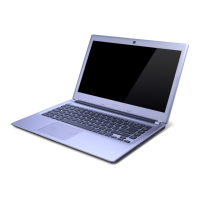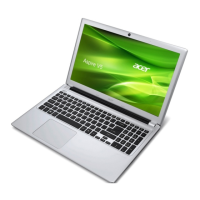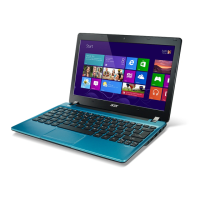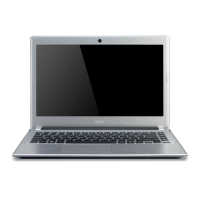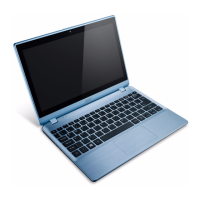
Do you have a question about the Acer Aspire V5-1 Series and is the answer not in the manual?
Read these instructions carefully. Keep this document for future reference.
Includes turning off for cleaning, plug usage, accessibility, listening safety.
Covers product warnings, electrical power safety, and usage guidelines.
Guidelines for safe battery usage, replacement, and maintenance.
Covers operating environment, interference with medical devices and pacemakers.
Safety considerations for vehicles, potentially explosive atmospheres, and emergency calls.
Instructions for product disposal, mercury advisory, and ENERGY STAR information.
Tips for comfortable use, finding comfort zone, and taking care of vision.
Advice on display settings, glare reduction, and developing good work habits.
Register your computer for faster service and community benefits.
Information on setup poster, User Guide, and Quick Guide for notebook features.
Learn how to turn computer on/off and basic care instructions.
Guidelines for caring for AC adapter, battery pack, and cleaning the computer.
Create factory default backup and drivers/applications backup.
Restore OS to factory defaults, retain user data, reinstall drivers/apps.
Steps to create a recovery disc for factory default or drivers/applications backup.
Steps to create a recovery backup on a USB flash drive.
Steps to solve problems by reinstalling software, drivers, or reverting to previous state.
Overview of recovery options: reinstalling software/drivers, reverting, or factory reset.
Reinstall factory-loaded software and drivers using hard drive or recovery discs.
Use System Restore to revert to a previous state using restore points.
Reset system to factory state, erasing all data. Backup important files.
Reinstall Windows and drivers from recovery discs using boot menu (<F12>).
Steps to solve problems by reinstalling software, drivers, or reverting to previous state.
Use System Restore to revert to a previous state using restore points.
Reset system to factory state, erasing data. Backup files. Recover from within Windows or startup.
Reinstall Windows and drivers from USB flash drive using boot menu (<F12>).
Browse media files on your computer and connected network devices.
Access and play shared files and folders from network devices.
Lists Acer devices compatible with clear.fi or DLNA software.
Stream media to other devices using 'Play to' feature.
Select and back up specific files and folders.
Create a complete image backup of the entire drive.
Copy files to a USB device to migrate them to a new computer.
Explains functions like execute, select, drag, and context menu with separate buttons.
Explains touchpad functions like open, select, drag with integrated buttons.
Details the function of Caps Lock, Num Lock, and Scroll Lock keys.
Explains Windows-specific functions accessed via the Windows key and combinations.
Locate and use special keys like Euro symbol and US dollar sign.
Describes battery technology, low-warning delivery, and charging.
Tips to extend battery life, including conditioning and proper usage.
Process to condition a new battery pack for optimal performance.
Step-by-step guide for installing and removing the battery pack.
Instructions on how to charge the battery using the AC adapter.
Checking battery level, optimizing life, and handling low battery warnings.
Steps to safely disconnect the computer from external accessories.
Tips for moving the computer over short distances within a building.
Advice for meetings and steps for moving the computer between office and home.
Guidelines for traveling with the computer, including home office setup and local travel.
Considerations for moving the computer between countries, including power and connectivity.
Setting Supervisor and User passwords for computer and data protection.
How password prompts appear and how to enter and set passwords.
Connect peripheral devices using computer ports.
Connect to an Ethernet-based network using the built-in feature.
Connect high-speed peripherals without using precious system resources.
Hardware configuration program for BIOS settings.
Setting boot sequence and enabling disk-to-disk recovery in BIOS.
Monitors system activity and stops devices to conserve energy.
Use onscreen error message reports to help solve problems.
Table of error messages and their recommended corrective actions.
Troubleshooting steps for power-on problems and blank screens.
Troubleshooting steps for no audio and unresponsive keyboards.
Troubleshooting printer problems and restoring system without recovery CDs.
Information to have ready when calling Acer for online service.
Device compliance with FCC rules, shielded cables, and peripheral requirements.
Statements for Canadian users, EU countries, and general radio device notices.
EU directive compliance and FCC RF safety requirements.
Maintain separation distance from antenna for FCC RF exposure compliance.
Specifications for LCD panel viewing distance, angle, illuminance, and polarity.

